Sample Environments
In partnership with its users, XMaS has a long history of developing new sample environments and the ability to apply external stimuli to samples. This allows both in-situ and in-operando studies and facilitates the broad interdisciplinary nature of materials research. Further details on our capabilities can be found through the links below.
We welcome interactions with new and existing users to increase our equipment portfolio. We have some limited funds to develop new systems, so please, get in touch with us if additional systems are required for your research activities.
Many of the sample environments described here are also compatible with our off-line x-ray source and laboratory, increasing the opportunities for material studies.
Applications to use these facilities are welcome.
Sample Goniometers
Room temperature sample holders must fit into the standard Huber range of goniometers (1001Link opens in a new windowLink opens in a new window and 1003Link opens in a new windowLink opens in a new window heads) or should have the same mounting ring.
Please contact us if you require any further information or detailed dimensions prior to any experimental time.

Sample Holders
Holders for regular APD cryostat (ARS DE202G):
For more information, see section 10 K - 300 K APD / ARS DE202 G

Holders for Joule-Thomson cryostat:
For more information, see section 1.7 K - 300 K He 4 ILL Joule Thomson Cryostat

Magnetic Fields
1 Tesla Electromagnet
The 1 Tesla electromagnet at the XMaS beamline, supported from the base of the Huber diffractometer, fits within the Eulerian cradle as shown below. The geometry allows the magnet to be oriented in one of three positions 90° apart, about the vertical axis. Thus both transverse and longitudinal fields may be applied, allowing the separation of spin and orbital contributions to magnetic scattering signals. Also the magnet may be rotated to allow the application of a vertical field in a horizontal scattering geometry. The geometry of the yoke allows for the maximum number of field turns within the geometrical constraints of the diffractometer. It can deliver a field of 1.0 T in an air gap of 50 mm. To achieve this with a magnet of manageable size, water cooled hollow conductors have been used for the coils. A magnetically efficient yoke configuration occupies the lower half of the vertical scattering plane, leaving the other half open for the cryostat and scattered beam. The yoke and poles have been manufactured from ARMCO® grade iron. The gap set at 50 mm, the homogeneity of the field in the middle of the gap in a co-axial cylinder, a = 5 mm, r = 2.5 mm is within 2% of the central value. Conical pole tips can be mounted on the adjustable poles and, with a 25 mm gap, a field of 1.5 T is achievable at a current of 250 A. |
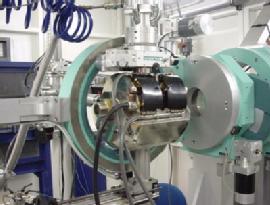 |
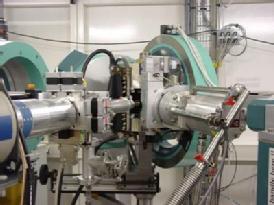 |
| B horizontal and along the incident beam |
B horizontal and perpendicular to the incident beam |
B vertical and perpendicular to incident beam |
The magnet specifications with a 50 mm gap are summarised below:
-
Minimum axial field in magnet centre at 250 A: 1.0 T
-
Space with good field homogeneity: 5 mm x 2.5 mm ∅
-
Weight: 77 kg
-
Cryostat opening: 65 mm ∅
-
Horizontal beam openings: 5 mm ∅
-
Maximum field reversing time: 1 s
-
Inductance: 5.5 mH
-
Maximum current: 250 A
-
Voltage: 22.6 V
-
Power: 5.65 kW
-
Field homogeneity: 2%
4 Tesla Superconducting Magnet
The XMaS/AMI superconducting magnet has been designed to fit within the Eulerian cradle of the Huber diffractometer and allows three field orientations. The geometry allows the magnet to be turned along the vertical axis through 90º, facilitating application of magnetic fields both along and transverse to the incident beam direction. Thus, both transverse and longitudinal fields may be applied. This allows the separation of spin and orbital contributions to magnetic scattering signal in non-resonant ferromagnetic studies. It may also be mounted to provide a vertical field allowing additional contrast in resonant magnetic scattering studies. It can deliver a field of 4 T in a large 40 mm opening warm bore with a 180º scattering aperture. An efficient yoke configuration occupies the lower half of the vertical scattering plane, leaving the other half open for the cryostat and scattered beam. The geometry of the coil former has been optimized to allow for a maximum number of turns within the geometrical constraints of the diffractometer. The combination of the 4 Tesla magnet and low temperature insert at XMaS enables detailed studies of complex field and low temperature (~1.8 K) phase diagrams. The 180° scattering aperture allows access to large part of the reciprocal space, so that important information on magnetic wave-vector dependence can be readily obtained. As this magnet can be used in vertical or horizontal scattering geometry, experimentalists can take advantage of either incident σ-polarised or π-polarised photons from the ESRF storage ring.
Design Concepts and Construction
The primary design requirements for this magnet were that it should be able to operate in any angular geometry, thus necessitating a cryogen free design. It was also decided that the magnet should be able to fit within the Eulerian cradle of the Huber diffractometer. Another important criterion for the design was a 180° open warm bore access for the scattered x-ray beam, allowing access to a very large area of reciprocal space. The three versatile operation geometries of the magnet mounted within the Huber diffractometer are shown below:
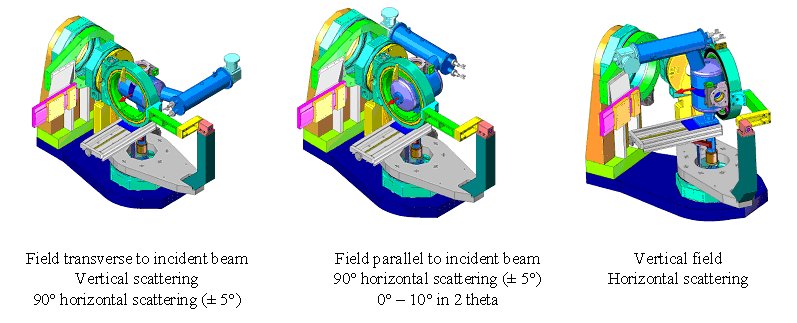 The XMaS/AMI superconducting magnet mounted within the Eulerian cradle on the Huber diffractometer, illustrating the three possible scattering geometries.
The XMaS/AMI superconducting magnet mounted within the Eulerian cradle on the Huber diffractometer, illustrating the three possible scattering geometries.
The superconducting magnet, shown below, is wound of twisted multifilamentary Niobium-Titanium (NbTi) superconductor embedded in a copper matrix. Twisted filaments maximise magnetic stability and minimise magnetic hysteresis. The former for the magnet coil is constructed of non-magnetic titanium alloy. Quench protection diodes are mounted within the magnet. The magnet system has been optimised to allow for a maximum number of ampere-turns within the geometrical constraints of the diffractometer. One of the most demanding requirements was the provision for 180° of clear room temperature radial access to the 4 Tesla central magnetic field, while maintaining a fixed, compact outer vacuum vessel which fits within the various Huber diffractometer configurations. At 4 Tesla, the split coil magnet produces a force of approximately 68 kN, which acts to collapse the 180° gap. The magnet former was designed to support these forces and be rigid enough to minimise coil movement, which could cause a premature quench (i.e., below 4 Tesla).
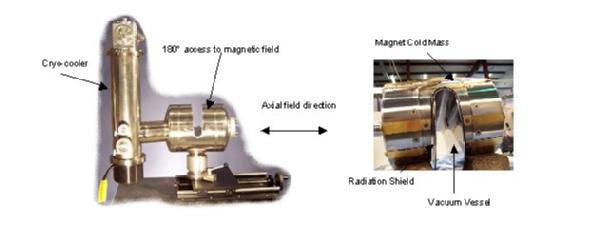 |
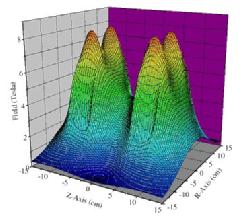 |
| A view of the completed magnet is shown (left), depicting cryocooler and open room temperature access to the magnetic field. A partially assembled view is also shown (right) illustrating the minimal spacing between the magnet cold mass, thermal radiation shield and the vacuum vessel. |
The 3D-magnetic field profile when the system is energised to 4.0 Tesla. Peak fields of ~8.5 Tesla can be seen within the windings at ~±7 cm along the z-axis. |
The field magnitudes are shown above, with the plots in the z-r plane. The z-axis is along the main axis of the split coil and the r-axis is along the radial axis of the split coil. Although the central field at z=0 and r=0 is 4 Tesla, the peak fields within the windings are approximately 8.5 T. This is approaching the critical field limit of about 9 Tesla for the Nb-Ti wire used in this magnet, with some margin for conduction cooling. A commercial Sumitomo closed-cycle refrigerator is used to cool the magnet system and AMI high temperature superconducting feedthroughs are installed to energise the magnet, whilst minimising the heat load on the refrigeration system. The requirement that the refrigerator should be located remotely from the magnet, due to the need for multiple orientations within the Huber diffractometer also caused a number of design concerns. The vacuum vessel of the magnet needed to support the weight of the refrigerator and to ensure a good thermal conduction path between the magnet and the cryocooler. Heat transfer between the magnet and the cryocooler is accomplished by thermal links located within the torque tube (LABEL). Differential thermal contraction is mitigated through flexible joints on both the first and second stage thermal links from the cryocooler. Another problem associated with multiple magnet orientations was locating the cold (< 4 K) magnet assembly within the radiation shield and vacuum vessel. Internal supports made from glass-fibre reinforced resin were designed to support the full weight of the magnet, about 34 kg, in radial and axial loading conditions, whilst simultaneously limiting the heat loads to the magnet to less than 200 mW. These supports also have to tolerate the dimensional changes due to the thermal contraction of dissimilar materials whilst locating the magnet in its correct position. In some areas, there is less than 4 mm between the cold magnet and the vacuum vessel at room temperature, as shown in the middle figure above.
The variable temperature insert is based around a RICOR 2/9 two-stage displex, capable of reaching 10 K. However, a third stage has been developed by the cryogenics group at the Institut Laue Langevin (ILL) in Grenoble. This novel device is capable of operating down to 1.8 K using 4He gas to within a few mK stability. It may also be operated over a wide range of angles without degradation of the base temperature.
In-Vacuum Magnet
The in-vacuum magnet has been designed to perform magnetic reflectivity (XRMR) measurements at low energies (down to ~3 keV) and low temperatures (~50 K). The whole magnet assembly is windowless to avoid absorption by entry and exit windows. The ±0.2 T magnetic field is applied in the plane of the sample and along the beam direction. The main body of the vacuum vessel has been constructed from aluminum. To ensure efficient cooling, the coil of the electromagnet is mounted ex-vacuum, below the vacuum vessel. The magnet yoke, which is made from ARMCO® grade iron, passes through the base of the vacuum vessel, sealed by double O-rings. An ARS DE202 displex sits on the xyz cryostat mount for precise sample alignment.
In-vacuum magnet mounted for low energy magnetic reflectivity (XRMR) measurements.
Electric Fields
The classic demonstration that a sample is ferroelectric is to measure a spontaneous polarisation that is switchable by the application of an electric field – namely a P-E hysteresis loop as shown below.
Polarisation versus Electric field (P-E) measurement of a poled soft PZT composition taken at 1 Hz, five consecutive loops overlaid.
Polarisation versus Electric field (P-E) measurement of a 1 μF ceramic multilayer capacitor taken at 1 Hz. The sample is a composite multiferroic with a sandwich of piezoelectric dielectric with magnetostrictive nickel electrodes.
In collaboration with the NPL Functional Materials Group, the XMaS team has developed an in situ system where P-E loops and X-ray diffraction data are collected simultaneously:

Schematic of the simultaneous acquisition of electrical response and x-ray diffraction during the sample excitation with a triangular electric potential.
The electrical response and the diffraction data can be measured simultaneously by means of a fast acquisition card (MUSST) under the application of either a constant or an oscillating field. The MUSST (Multipurpose Unit for Synchronisation Sequencing and Triggering) card, developed by the ESRF, can collect data in each separate channel at rates up to 20 MHz.
This development aims to help users to carry out studies of ferroelectrics and multiferroics in complex conditions such as magnetic and electric fields. Currently XMaS offers an electric field sample environment with potentials of ± 2 kV with temperatures down to 2 K in a 4 T magnetic field. A separate sample environment provides ± 10 kV down to 10 K in a 1 T field. Samples must be coated with e.g. gold electrodes and electrically isolated by a sapphire support. The high voltage (HV) wires that are connected to the cryostat are soldered onto the gold.
For more details on the P-E measurement system, please contact the team or Mark Stewart at NPL.
 |
More information can be found on the Multiferroics wiki development by NPL and XMaS.
Custom Sample Environments at XMaS
If any custom sample environments are required, please contact a member of beamline staff as soon as possible and we will try to accommodate you. Previous examples have included equipment for performing in situ studies of surfaces in the electrochemical environment. Electrochemical cells have been developed to allow control of the solution and sample temperature over the region of -5 to 80°C and to permit studies of electrochemistry in a magnetic field. Preliminary experiments on the surface reconstructions of Au(111) and Au(001) in electrolyte have been performed.
Low and High Temperatures
10 K - 300 K APD / ARS DE202 G
The ARS DE202G is a closed cycle cryostat which uses high pressure helium gas to produce cooling down to about 10 K. A helium compressor provides high pressure gas to the cryo-cooler through a flexible gas line. The expansion of the gas at different stages produces the refrigeration. Low pressure gas is then returned through another gas line where it is recycled through the compressor. This closed loop cycle can be continuously repeated and maintained as needed to produce the desired refrigeration. The DE202G cryostats on XMaS are designed to mount directly onto the phi circle of the Huber diffractometer and can be oriented in any direction at base temperature. Currently there are two of these cryostats on the beamline, one with a silicon diode and a Cernox® temperature sensors and a second with two Cernox® sensors for use in magnetic fields.

Both the vacuum shroud (380 µm thick wall) and radiation shield (280 µm thick wall) are equipped with beryllium domes for x-ray studies allowing full access to the sample. The vacuum shroud is constructed from non-magnetic stainless steel which slips over a double o-ring on the refrigerator for easy sample change. The radiation shield is constructed from nickel plated copper for effective heat transfer. The distance from the APD cryostat ''cold finger'' tip to the centre of rotation of the diffractometer is 17.5 mm. Samples are usually mounted onto a 6 mm diameter copper stub, that can then be mounted into a standard sample holder. For larger or unusually shaped samples, mounts can be made on request. Please contact the beamline staff to discuss your requirements before arriving for the experiment.
10 K - 600 K ARS DE202G Cryofurnace
This cryofurnace is based on the ARS DE202G. The 600 K interface mounts on the cooler and contains an internal mechanical thermal switch which protects the cold end from excessive heat while experiments are carried out at elevated temperatures. A RhFe sensor reads the temperature at the sample position between 16 and 600 K. A silicon diode sensor mounted on the other side of the thermal switch reads temperatures down to 10 K.
1.7 K - 300 K He 4 ILL Joule Thomson Cryostat
| In addition to a commercial standard 2-stage displex cryostat, which operates down to about 10 K and mounts on the phi circle of the diffractometer, a specially adapted 3-stage displex capable of sample temperatures down to 1.7 K is in routine use. This novel device, which has been developed by the cryogenics laboratory at the Institut Laue Langevin (ILL), Grenoble, may be operated over a wide range of angles without degradation of base temperature. The 3-stage device is ~40 mm longer than a standard displex, but is installed into the same motorised phi circle mount as all of the other cryostats. Both the vacuum shroud (500 µm thick wall) and radiation shield (300 µm thick wall) are equipped with beryllium domes. |
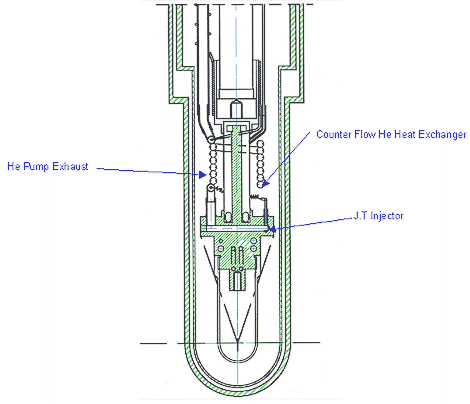 |
1 K - 300 K He 3 ILL Joule Thomson Cryostat
Using the above Joule Thomson cryostat with 3He gas, instead of 4He, test experiments have been made with sample temperatures down to 1 K.
Temperature Controllers
The standard temperature controller used on the beamline is the Lakeshore model 340 (discontinued, replaced with model 350). This controller has four inputs and supports a wide range of temperature sensors. Further details of this controller can be found on the Lakeshore websiteLink opens in a new windowLink opens in a new window.
Furnaces and Temperature Controllers (on request only!!)
A series of furnaces from the ESRF Sample Environment pool, Eurotherm controllers linked to Delta Elektronika power supply SM120-50 or SM120-25 can also be used (on request only!!). The Eurotherm controller is integrated in SPEC and PID parameters, ramp rates, etc. can be changed remotely. Please contact us for further details.